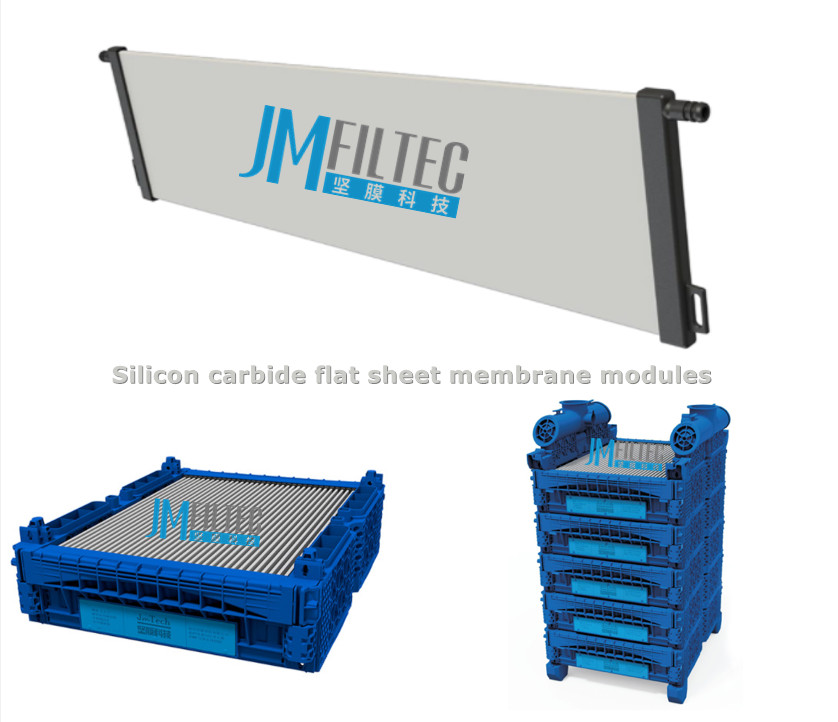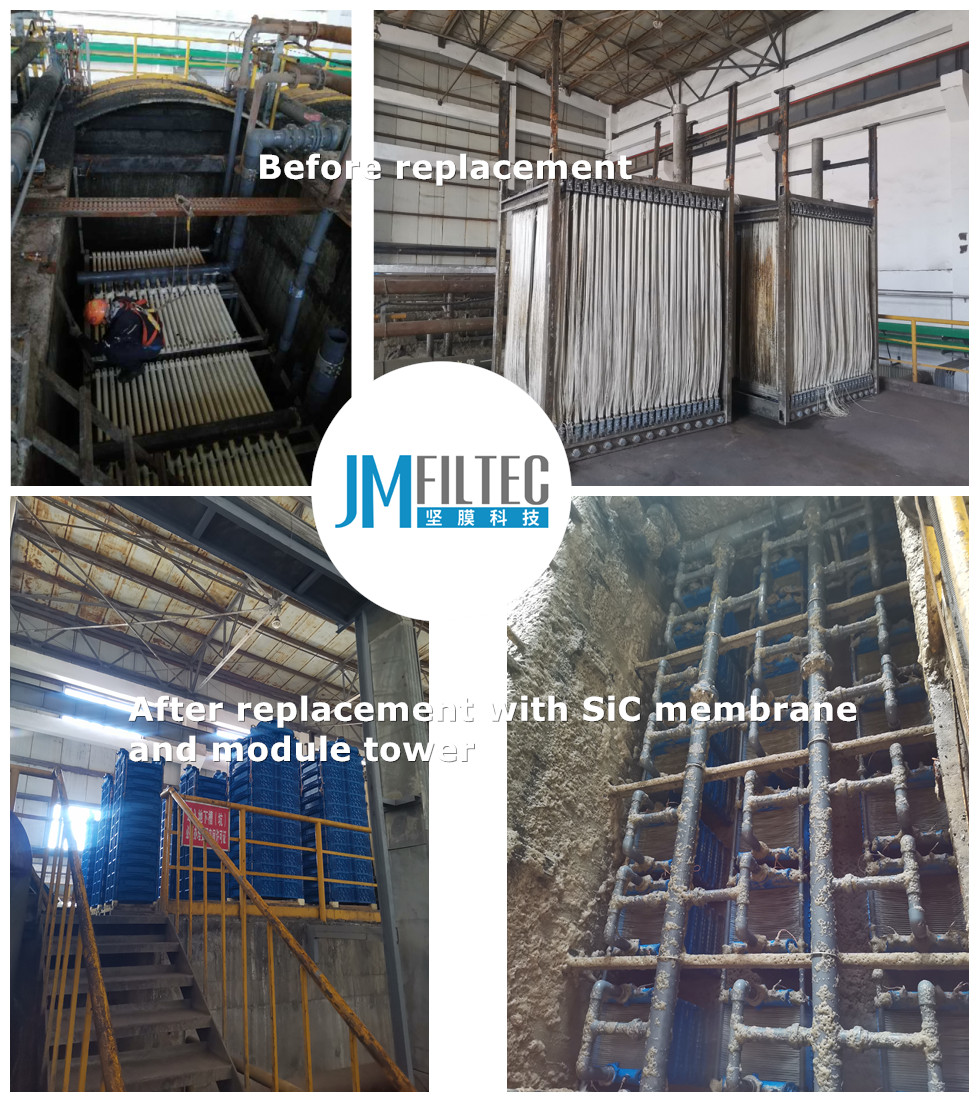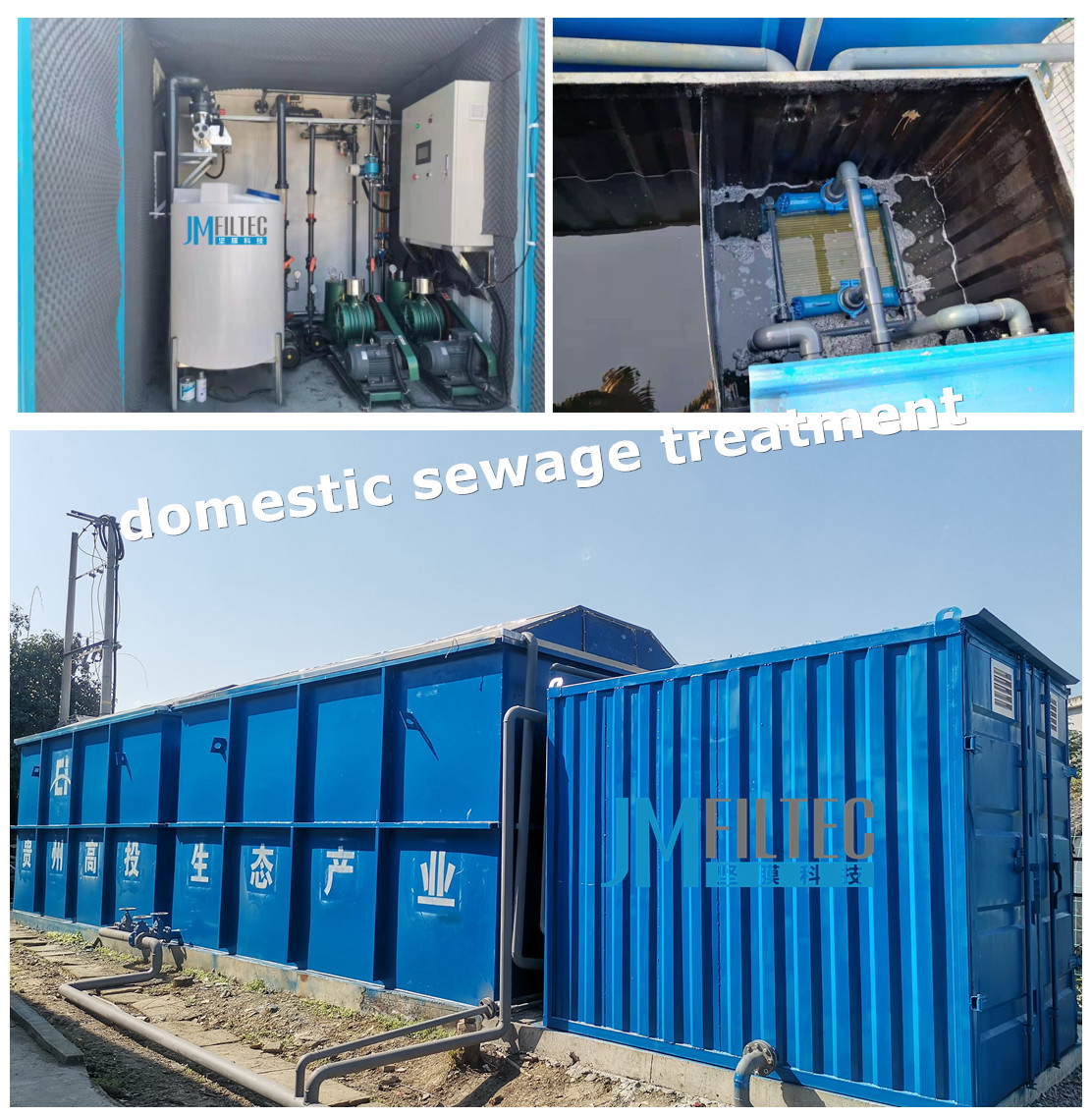Introduction of MBR System application
2021-06-18
Introduction of MBR System application
What is MBR ?
MBR is the abbreviation of Membrane Bioreactor. It is a new and efficient wastewater treatment process that combines microfiltration n or ultrafiltration membrane separation technology with traditional activated sludge process(ASP). The main purpose is to reject the solid materials which are developed by the biological process, resulting in a clarified and purified high quality effluent water.
The process difference between MBR and ASP.
Basically, MBR uses membrane modules to replace the secondary sedimentation tank or clarifier in the conventional ASP, intercepts a large number of microflora and suspended solids in the biological system by forming cake layer on the membrane surface, it improves the capacity and efficiency of sewage treatment. As a result, the effluent quality and volume load of the system have been greatly improved, and the effluent can be used as reclaimed water.

The five advantages of MBR system
1.Effluent quality is stable and high level.
Better separation effect than the traditional sedimentation tank, the treated effluent is extremely clear, a membrane is used as an absolute barrier, TSS and turbidity are close to zero, bacteria are greatly removed as well. At the same time, the microorganisms are completely intercepted in the bioreactor, which enables the system to maintain a high microbial concentration, which not only improves the overall removal efficiency of foulants, but also ensures a good effluent quality. On the other hand, the reactor has good adaptability to various changes of influent load, high resistant to impact load, and can stably obtain high quality effluent quality.
2.Small footprint
Almost 50% less space in comparison to ASP (no clarifiers are needed, a small often rectangular shaped tank housing the membrane modules, less equipment),high concentration of microbial biomass can be maintained in the bioreactor, the increased concentrations mean that the same total mass of solids is contained in a smaller volume, so the footprint is smaller.
3.Simple operation, easy management
Independent HRT and SRT – sludge retention time (SRT) and hydraulic retention time (HRT) are completely independent since sludge solids are completely retained in the bioreactor, the operation control is more flexible and stable, it can be controlled automatically by microcomputer, convenient handling.
4.Low sludge production
The process can be operated under high volume volume load and low sludge load, less sludge is produced and needs to be disposed less frequently than in CAS.
5.Easy for maintenance and cleaning
Membrane elements are resistant to oxidation, high temperature, strong acid and alkali, solvent. Submerged operation allows a variety of cleaning schemes, more than 15 years lifespan, unique membrane module design, easy to assemble and disassemble just like LOGO bricks.
The disadvantages of MBR system
Actually, the MBR also has some shortcomings as follows:
1.Higher membrane cost, the infrastructure investment of MBR is higher than that of traditional sewage treatment process.
2.Membrane fouling control
3. High energy consumption
Membrane products used in MBR System
1.Membrane material
According to the different materials, the membrane elements are mainly divided into organic polymer membrane and inorganic ceramic membrane.
Organic polymer membranes are mainly made from polymer materials like PVC, PVDF, PES, offer the advantage of low-cost production, mature manufacturing process, various pore size and shapes are available, but are prone to fouling and degradation, shorter lifespan.
Most of the inorganic membranes used in MBR system are ceramic membranes, such as alumina, zirconia and silicon carbide ceramic membrane elements, it has incomparable advantages over polymer membranes: narrow pore size distribution, high separation efficiency and stable filtration effect. It has good chemical stability, high mechanical strength and resistance to acid, alkali, organic solvents and high temperature.
At present, the silicon carbide membrane produced by Jmfiltec is the top-grade product in the field of inorganic ceramic membrane, and it will also become a new application trend in the field of membrane separation. SiC membrane products have better characteristics and advantages of the than those of conventional alumina and zirconia ceramic membranes. You can check it out the comparison details from this article: https://jmfiltec.com/News-silicon-carbide-membrane/37

2.Membrane pore size
The membrane used in MBR process is generally microfiltration membrane (MF) and ultrafiltration membrane (UF), with a pore diameter of 0.01 ~ 1 μ m, which is sufficient for solid-liquid separation membrane reactor.
3.Membrane modules.
In order to facilitate industrial production and installation, improve the working efficiency of the membrane, and achieve the maximum membrane area per unit volume, the membrane is usually assembled in a basic unit equipment, and the solid-liquid separation is completed under a certain driving force, this kind of device is called membrane module.
Major membrane module types used in industry: hollow fiber module, plate and frame module, Spiral Wound module, tubular module, capillary module.
At present, the plate-frame module is the main application for MBR system, it is one of the earliest membrane module type used in MBR process, with application advantages: simple assemble and production, convenient cooperation, easy maintenance, cleaning and replacement. In MBR system, the module is often put directly into the reactor without pressure container to form an immersed membrane-bioreactor. Generally, it is an external pressure type membrane module.
Main applications of MBR
1.Domestic and municipal wastewater treatment
Domestic or Municipal wastewater is generally treated to meet statutory requirements for discharge to environmental waters. MBR system has high treatment efficiency for contaminants removal, such as bacteria, organic matters, TSS, COD, turbidity and reduces the concentration of those foulants to as low as 9mg/L under all operating conditions. The small footprint of MBR systems makes it ideal for application in remote areas where wastewater can be reduced for irrigation or ground water recharge.
2.Water reuse or recycling
Due to the increasing water demand and fierce water crisis all over the world, water reuse and water reclamation, as alternatives to natural water resources are drawing more and more attention. MBR system has been playing a very important role as a new and effective way for various kind of wastewater treatment, provides the effluent that meets the standard of environmental protection water reuse. MBR effluent is ideal for further treatment by reverse osmosis. The high quality of the MBR permeate allows increased RO flux with reduced fouling.
3.Industrial wastewater treatment
Suitable for landfill leachate, sludge concentration, high BOD food processing wastewater, livestock wastewater, cosmetic products processing wastewater, petrochemical wastewater. pulp and paper wastewater, etc. The removal rate of COD/BOD/SS can reach more than 94%.
Jmfiltec MBR application case show
Project 1 Overview:
User: Inner Mongolia Coal chemical company
Project target: membrane replacement, 1863㎡ of silicon carbide flat sheet membrane to replace 3840㎡ of Zeeweed 500D hollow fiber membrane
Project scale: 4 × 70m ³/ hr, we have replaced four membrane tank with silicon carbide membrane.
The existing problems: the hollow fiber curtain membrane was seriously broken after a half year use, which affected the normal operation of the following RO system.
Process route: coal chemical industry concentrated salt wastewater→cyanide breaking tank→fluorine removal tank →inclined plate sedimentation tank→softening tank→inclined plate sedimentation tank→ biochemical reaction tank→MBR membrane tank→primary reverse osmosis →secondary reverse osmosis→water reuse tank.
Stable flux after the membrane replacement : 60LMH

Project 2 overview:
User: Guizhou Gaotou Ecology.
Project content: new project for municipal sewage treatment
Project size: 30 × 50m ³/ day, a total of 30 sets.
Process route: collection tank→air floating tank→regulating tank→anaerobic tank→aerobic tank-MBR membrane tank→discharge.


 English
English 中文
中文






